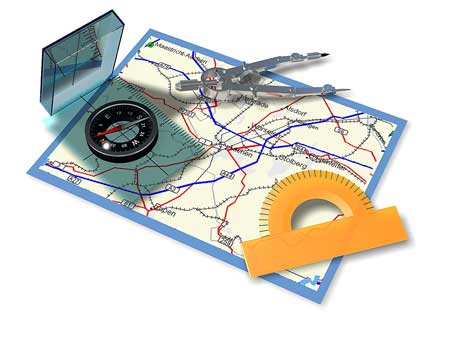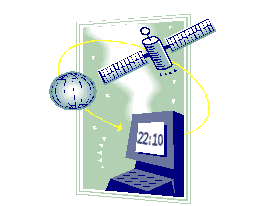|
| |
Glossary of GPS Terms
AFE:
Atlas Florae Europaeae. The AFE grid is modified from the
Military Grid Reference System (MGRS). .
Antarctic Circle:
An imaginary circle on the surface of the earth at 66.5°S lat. or
23.5° north of the South Pole.
Arctic Circle:
An imaginary circle on the surface of the earth at 66.5°N
latitude, or, 23.5° south of the North Pole.
BIPM:
Bureau International des Poids et Mesure. The international bureau
of weights and measurements, in Paris. Responsible for the UTC time scale.
BRG:
Bearing. The direction to the to waypoint.
CDMA:
Code Division Multiple Access. a technology where different
radio's can work on the same frequency. GPS uses it.
CODE PHASE GPS:
GPS measurements based on pseudo random code (C/A or P) as
opposed to carrier of that code.
C Code:
The less accurate Civilian GPS Signal.
COG:
Course Over Ground, Your current direction of travel relative to
a ground position (same as Track).
CONUS:
Continental United States. An abbreviation used in a class of
Datums.
CTS:
Course To Steer.
CMG:
Course Made Good. How you are progressing towards your next
waypoint.
Datum:
Map Datum's are the reference system used between the Lat/Longs
and the map being used as a reference.
Dead Reckoning:
A very simple method of using time and distance to navigate.
Deviation:
Errors from your course. Either built in or unintentional. One
type of deviation is magnetic, the difference between a true course and what a
compass will tell you.
DGPS:
Differential GPS. A local transmitter is used for greater
accuracy.
DBR:
Differential Beacon Receiver. Differential Beacon Receivers tune
to the United States Coast Guard's high differential correction beacon stations
for improved position accuracy.
Dithering:
The introduction of digital noise. This is the process the DOD
uses to add inaccuracy to GPS signals to induce Selective Availability (SA)
DMA:
Defense Mapping Agency.
DOP:
Dilution of Precision, errors caused by bad geometry of the
satellites.
DTK:
Desired Track. The course between To and From.
EGNOS:
The European WAAS.
EPE:
Estimated Position Error. How much the unit thinks it is off
target.
Equator:
Zero degrees Latitude. A line around the center of earth
24,901.55 miles (40,075.16 kilometers) long.
ETA:
Estimated Time of Arrival.
ETE:
Estimated Time Enroute.
FGDC:
The Federal Geographic Data Committee (FGDC)
Fix:
A position that is determined by the navigation unit.
Galileo:
Europe's GPS system. May be operational by 2008.
GANS:
The Air Force's Global Access, Navigation, and Safety (GANS)
program.
Geocaching:The
sport where you are the search engine, and you have to hunt for treasure caches
with your GPS .
GDOP:
Geometric Dilution of Precision, see DOP.
Getting:
Ivan A. Getting, Father of the GPS
GLONASS:
The Russian equivalent to the NAVSTAR GPS.
GMT:
Greenwich Mean Time or UT1 (Universal Time One) or UT is a time
scale tied to the rotation of the Earth in respect to the fictitious 'mean Sun'.
UTC is, however, kept within 0.9 seconds of UT1, by virtue of leap seconds.
GMAT:
Greenwich Mean Astronomical Time. Prior to 1925, in astronomical
and nautical almanacs, a day of Greenwich Mean Time began at noon. This
reckoning of Greenwich Mean Time is now called Greenwich Mean Astronomical Time,
and is no longer used.
GPS:
Global Positioning System. Usually refers to the USA's NAVSTAR
system.
Great Circle Route
A great circle is defined as a circle on the earth's surface the
plane of which passes through the center of the earth.
For navigation purposes :
GS:
Ground Speed.
GWEN:
Air Force Ground Wave Emergency Network

Handshaking:
coordination settings
that allow or prevent
communication between computer and a device
Illumination:
The signal coming from the GPS Satellites.
Isogonic Lines:
A line on a map or chart where the magnetic deviation is the
same.
ITU:
International Telecommunication Union
JPALS:
Joint Precision Approach and Landing System, is a DGPS system pro
rapid deployment. Uses WAAS/LAAS
LAAS:
Local Area Augmentation System.
LDGPS:
Local Differential GPS. Two or more GPS Receivers are used to
create a local reference to each other.
Magnetic North:
The direction to the Magnetic North Pole. It is what a magnetic
compass indicates. It is different from True North, by the value of the Mag.
Var.
Mag. Var.:
Magnetic Variation. the different between true North (pointing
towards the geographic pole) and Magnetic North (pointing towards Magnetic Pole)
where a compass points to.
Map Datum:
What reference map is used in determining the Fixes.
Map Projections:
A curved surface has to be "projected" onto a flat surface (the
map paper). Mercator, Orthographic and Conic are common types of projections.
MCX:
Antenna connector used on some of the newer GPS units.
MGRS:
Military Grid Reference System. The MGRS is an alphanumeric
version of a numerical UTM (Universal Transverse Mercator) or UPS (Universal
Polar Stereographic) grid coordinate
MOPS:
Minimum Operational Performance Standards.
MSAS:
The Japanese WAAS.
NANU's:
NOTICE ADVISORY TO NAVSTAR USERS
NAD27:
North American Datum 1927. It is broken down into different
areas, from Central America to Greenland.
NAD27 CONUS:
North American Datum 1927, Mean Value
NDGPS:
Nationwide Differential GPS, The NDGPS plan calls for the
conversion of a number of U.S. Air Force Ground Wave Emergency Network (GWEN)
sites to broadcast DGPS signal. The range is 250 miles.
NEMA:
National Electrical Manufacturers Association
NEMA 0183:
A communication protocol used by GPS units and other types of
navigation and marine electronics.
NIMA:
National Imaging and Mapping Agency.
NSDI:
National Spatial Data Infrastructure.
OSM:
Ordnance Survey Maps. Britain's national mapping agency
P Code:
Precision Code. The more accurate GPS signal.
PPS: Pulse Per Second. Many receivers pulse their data at the top of
every second facilitating timekeeping.
Prime Meridian: The
zero longitude location from where east and west is measured. It passes through
Greenwich, England.
Pseudolite:
An extra satellites like device, installed on the ground in the
local area. It is used to supply "illumination" and correction signals for DGPS
systems.
Rhumb Line:
A line that passes through all meridians at the same angle. When drawn on a
Mercator chart, the rhumb line is a straight line, because the Mercator chart is
a distortion of a spherical globe on a flat surface. The rhumb line results in a
longer course than a great circle route.
RNP:
Required Navigation Performance standards.
RS232:
The electronic voltage and timing interface definition for the
connection of electronic equipment. Often used to connect NMEA devices to
computers.
RTCM:
Radio Technical Commission for Maritime Services
RTK OTF: Real-Time
Kinematic (RTK) On-The-Fly (OTF) positioning. A DGPS technique for high
precision positioning of moving objects.
Serial: Data that is sent one bit after another. A serial port on a
computer is also called a COM port. See RS232
SMG:
Speed Made Good. Marine term giving speed to waypoint taking into
effect the course you are steering.
SOG:
Speed Over Ground.
SPS:
Standard Positioning Service (civilian GPS).
SA:
Selective Availability (intentional degradation of SPS). If they
desire, the
US military can turn off the accuracy of the GPS system.
SOIT:
FAA's Satellite Operational Implementation Team.
Statute Mile:
A unit of length equal to 5,280 feet or 1,760 yards (1,609
meters) used in the U.S. and some other English-speaking countries.
Track:
Your current direction of travel relative to a ground position
(same as COG, Course Over Ground).
Triangulation:
by accurately measuring our
distance from three satellites we can determine our position anywhere on earth.
Tropic of Cancer:
An imaginary circle on the surface of the earth at 23.5°N
latitude.
Tropic of Capricorn:
An imaginary circle on the surface of the earth at 23.5°S
latitude
True North:
The direction to the geographic North Pole. It is different from
Magnetic North, by the value of the Mag. Var.
USGS:
U.S. Geological Survey.
UPS:
Universal Polar Stereographic, a version of UTM
USNG:
US.
National Grid.
UTM:
Universal Transverse Mercator, A type of map projection. The grid
lines you see on a USGS Quads represent a map projection known as Universal
Transverse Mercator (UTM), and are 1000 meters apart.
UT or UT1:
Universal time or GMT (Grenwich Mean TIme) See GMT. It is
different from UTC ( difference can be almost 1 second). UT1 is the
electronically distributed version. See also UTC for differences
UTC:
Coordinated Universal Time. There are 7 Universal Times (all
within 1 second of each other), and UTC is the "coordinated version of
'Universal Time'", hence the word order of Coordinated Universal Time. The
abbreviation UTC is a language-independent international abbreviation, it is
neither English nor French. It means both 'Coordinated Universal Time' and Temps Universel Coordonné. This is
a time scale based on atomic clocks, by definition cesium clocks. UTC is the time
basis for GPS.
means both 'Coordinated Universal Time' and Temps Universel Coordonné. This is
a time scale based on atomic clocks, by definition cesium clocks. UTC is the time
basis for GPS.
VMG:
Velocity Made Good. Marine term. Effective velocity to waypoint
taking into effect the course you are steering.
VOG:
Velocity Over Ground. Same as Ground Speed.
WAAS:
Wide Area Augmentation System
Waypoint:
A navigation fix. Usually a destination or point of reference.
WGS84:
World Geodetic Survey 1984. A common map datum reference
WRC:
World Radio Conference, an international conference where
standards and interference issues are discussed.
Y Code:
P Code that has been encrypted.
Back to top
For more Information:
Advanced Features
of Star Sync software
Star Sync GPS Receivers
- Installation Information
GPS Technology
Frequently Asked Questions about GPS
Star Sync Main Page
Star Sync Site Index
| |
|


